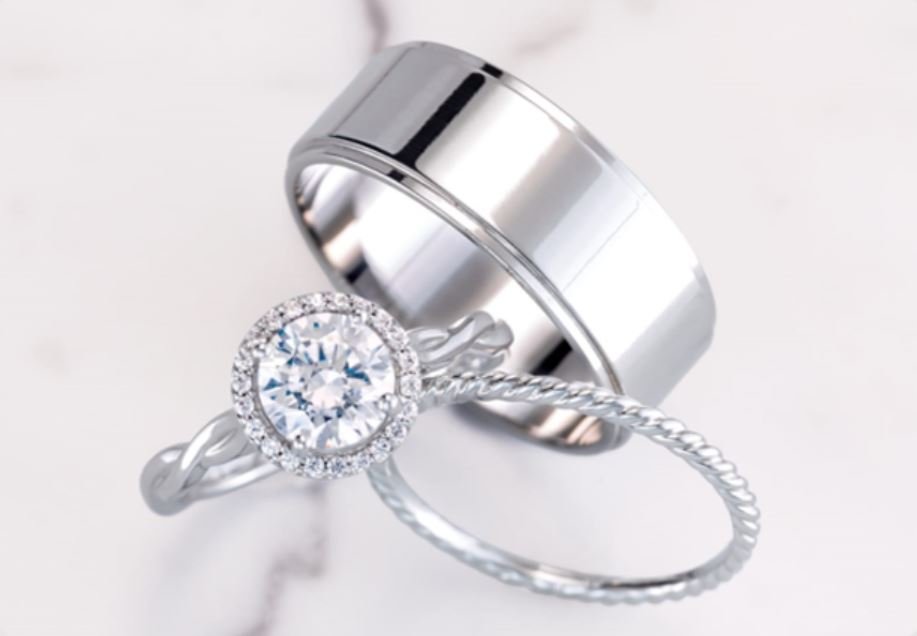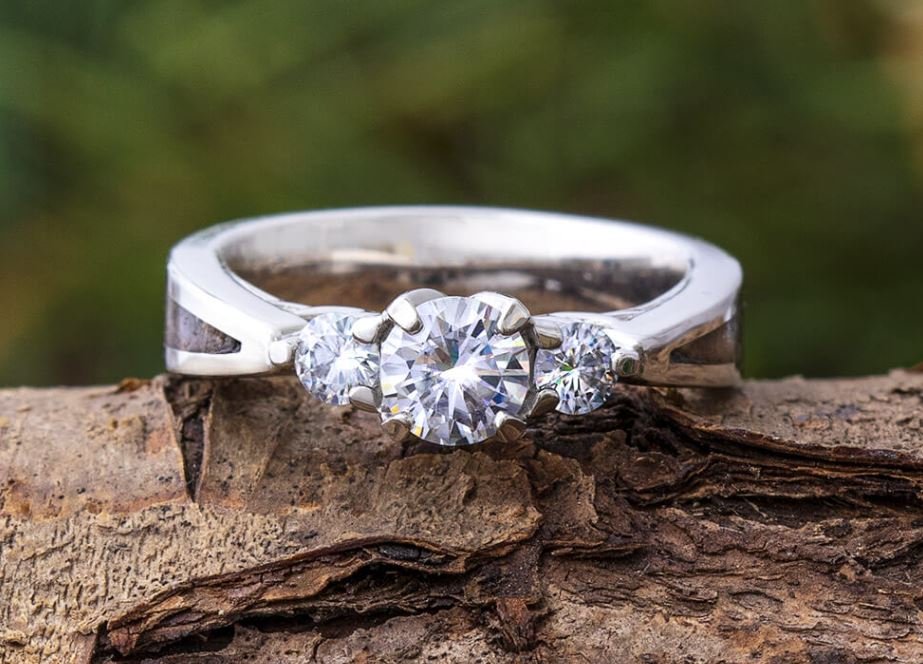White Gold vs Sterling Silver
White gold is a superior option compared to sterling silver. White gold does not tarnish or react with sensitive skin. It also has a premium gold feeling and resale value which sterling silver can never get to. Sterling silver can tarnish and become non-hypoallergenic as well. If you have the budget of buying white gold jewelry, then definitely go for white gold. Sterling silver should be the second option.
In this article we’ll do a comparison of sterling silver vs white gold and state what should you buy.
What is White Gold?
White gold is an alloy of pure gold made by combining pure gold with a white metal like platinum, zinc or sterling silver. Whole idea of making this alloy is to give gold some hardness and strength to withstand the pressure of jewelry making. White gold is available in many purities from 9 karat to 20 karat where 20 karat is the most pure alloy. As you go down, purity of the metal decreases and gold alike properties become less prominent.
Why Choose White Gold?
White gold offers a number of benefits.
1. Hypoallergenic
White gold is a hypoallergenic metal. Meaning it does not react with the skin and can be easily worn by people with sensitive skin. It does not contain any copper or other non-hypoallergenic metals.
Sometimes, white gold can also be non-hypoallergenic when nickel is mixed with gold in its composition instead of zinc or silver. This tactic is used by jewelers to save cost as nickel is very cheap. So, it is better to ask your jeweler first what kind of metal are they selling.
2. Non-Tarnishing
Tarnishing is a big problem with metals containing copper. It is a chemical reaction in which copper reacts with atmospheric chemicals to form a dull layer over shiny surface. Though, tarnishing is treatable but it adds cost and maintenance time. Fortunately, white gold does not tarnish. This saves cost of tarnish removing chemicals and maintenance time of yours. If you are a person who does not want to spend time of cleaning your jewelry or is looking for a piece for a special event, then white gold is the better choice.
3. Resale Value
Resale value of gold has always been better than other metals. White gold jewelry has a great resale value compared to other low cost metals like sterling silver or stainless steel. If you decide to sell your jewelry in future, white gold can be a better option with good resale value. However, it should be noted that brand price is not a part of resale value. For example, if you buy jewelry from Cartier, you are paying for the brand price as well which will never be included in resale value. Resale value will be calculated as per worth of your jewelry’s metal and stones.

Sterling Silver
Sterling silver is an alloy of silver being used in jewelry making for centuries. Its usage dates back to even a thousand year ago. It is made by combining 92.5 percent pure silver and 7.5 percent copper by weight. Due to this addition of copper, sterling silver becomes reactive towards sensitive skin. It can react with sensitive skins and turn them green or black. Another problem with sterling silver is tarnishing. Tarnishing is a chemicals reaction in which a dull black layer forms over sterling silver making it appear ugly. This tarnishing can be removed but involves usage of tarnish removal chemicals which add cost.
Why Choose Sterling Silver
Sterling silver comes with a number of benefits.
1. Affordable
Biggest advantage of sterling silver compared to white gold is being affordable. Gold is an expensive metal coming with a big price tag. Normally, for everyday jewelry you cannot spend such big amounts. In such a situation, sterling silver becomes a great choice given you can spend time and some extra money on its maintenance. You can easily get a pair of earrings made in sterling silver for as low as $30.
2. White Appearance
Many people like white looks of their jewelry. Sterling silver has a bright white appearance which can resemble premium white metals like platinum and rhodium etc. at a very low cost. This makes sterling silver not only appear white lustrous but also shine as much light as possible. In some cases, in appears even brighter than white gold.
3. Variety of Designs
Sterling silver can easily be found in many designs and customization options. You can found almost any type of jewelry from earrings to brooches and even hair pins. This makes sterling silver a good choice of those who want either high level customization or really unique looks from their jewelry. Many jewelers deal it sterling silver and these items can be found both in online and offline stores.
White Gold vs Sterling Silver – A Comparison
Here is a full-on comparison of white gold vs sterling silver.
1. Appearance
We all know that pure gold has a bright yellow color. Whenever a white metal is added to it in order to make white gold, this yellow appearance does not go easily. So, to get a bright white color, more and more white metal has to be added which decreases its purity. That’s why 18 karat white gold (higher purity gold alloy) appears less white than 14 karat or 10 karat. But, this losing of purity leads to less gold alike properties in the metal as gold content is decreasing. So, you will see some people getting their white gold plated with rhodium giving a much whiter and brighter look.
Sterling silver appears brighter than higher purity white gold. It has a bright white appearance resembling platinum or rhodium.
2. Durability
White gold is more durable than sterling silver. It is more hard than silver making it resist scratches and other damages better. It is also a non-tarnishing metal which will also increase its durability.
Sterling silver is also a durable but prone to scratches metal. It is likely to get more scratches than white gold in daily life routine.
3. Cost
Understandably, white gold is an expensive metal as it contains gold. White gold costs about 10 to 15 times more than sterling silver. This price can increase more if you are buying from a reputable brand. A normal sized ring made in white gold weighing about 3 grams can cost about $600.
Sterling silver is a low cost metal. It costs way less than white gold and can be a good option for those who don’t have a big budget. It is also a great option if you are buying jewelry for every day wear. A sterling silver ring with a normal size weighing about 3 grams can cost around $40.
4. Maintenance
Maintenance is the core concerning factor for people who are either office going or don’t have much time to spend on their jewelry. White gold needs less maintenance compared to sterling silver. You can do cleaning once a month with regular use whereas sterling silver can require cleaning once every 15 days for better looks. Moreover, if you clean sterling silver regularly, tarnish will not develop.
5. Hypoallergenic
This factor is the most important one for people with sensitive skin. Sterling silver is a reactive metal which can cause skin allergies like redness, itching or even blisters to people with history of sensitive skin. White gold, on the other hand does not cause any allergic reaction given nickel is not added. Nickel is the most non-hypoallergenic metal occasionally added in white gold to save cost. That’s why always check with your jeweler about nickel’s addition in white gold.
Sterling silver can react with skin and turn it black. This coloration of skin is temporary and not a big concern. But it can also come with redness or itching. So, people with sensitive skin should not use silver.

6. Variety of Designs
White gold is not made as extensive as yellow gold. So, less number of jewelers deal in it. This will come with a limitation of design or customization options for buyers. Though, a lot of variety is available for engagement or marriage rings, every day jewelry designs might be not frequently available.
Sterling silver is a common metal found in almost every jewelry shop. A variety of designs, patterns, styles and types of jewelry can be available in it. Customization options can also be easily available i.e. name necklace, three stone ring etc.
White Gold vs Sterling Silver – What to Buy?
If you are looking to buy jewelry for a special event or memorable day, then definitely go for white gold. Sterling silver is an affordable metal which might not give a good impression. However, if you are buying jewelry for everyday wear and can spend some time on maintenance, then go for sterling silver. Apart, if budget is also a concern, sterling silver is the choice. If you have sensitive skin and have a history of getting skin reactions from silver, then white gold is the best option.

